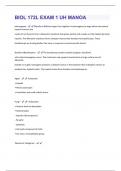Tentamen (uitwerkingen)
BIOL 172L EXAM 1 UH MANOA QUESTIONS WITH 100% VERIFIED SOLUTIONS!!
- Vak
- Instelling
plasmogamy - Mycelia of different types fuse together in plasmogamy (a stage where two parent mycelia fuse but the nuclei do not fuse) to form a dikaryotic mycelium that grows quickly and crowds out the haploid parental mycelia. The dikaryotic mycelium forms compact masses that develop into basi...
[Meer zien]




